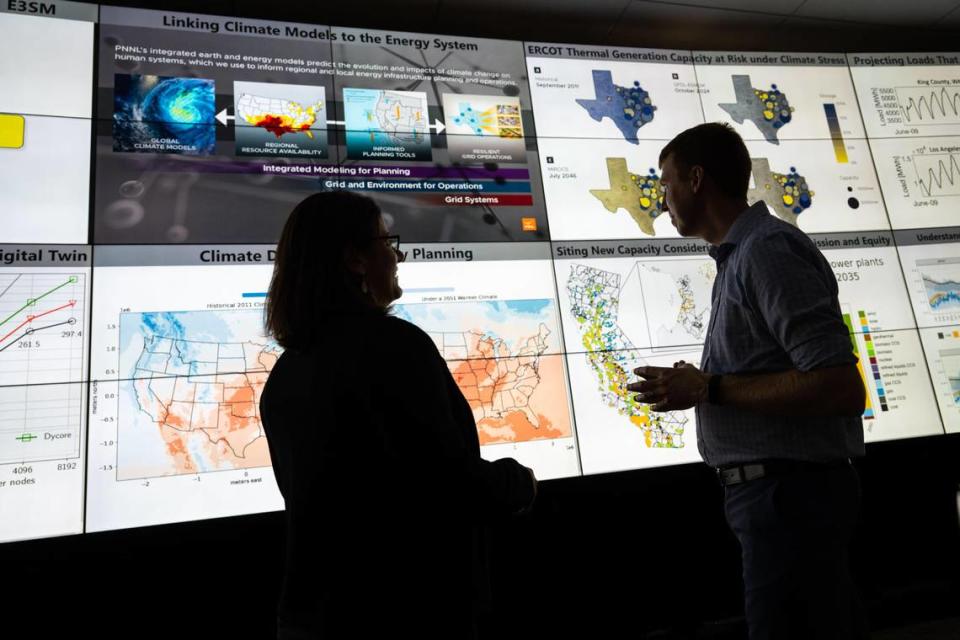From intense hurricanes to more wildfires. PNNL models provide clarity on climate changes
Understanding and addressing the impacts of climate change is one of the most daunting challenges of our time. The complexities of interconnected natural and human systems make it extremely difficult to identify meaningful solutions.
Just as problematic is knowing which actions will yield the greatest benefits in the near and long term — and whether they will be enough.
At the Department of Energy’s Pacific Northwest National Laboratory, researchers develop and apply data-rich models to create an integrated view of the dynamic Earth, energy and economic systems, including the interactions among them. Their work seeks to understand the implications of climate change, for example, studies that suggest increasingly intense hurricanes and more frequent wildfires.

They also aim to inform decisions to prevent or mitigate these impacts. For example, since 2015, PNNL and collaborators have used a global model to assess countries’ commitments to reduce greenhouse gasses and whether global warming can be kept below 2 degrees Celsius (compared to pre-industrial times), a goal set by the Paris Climate Agreement.
Relying on this model, research at the Joint Global Change Research Institute, or JGCRI (a partnership between PNNL and the University of Maryland), suggests that if countries honor their climate pledges, the world could meet this goal by the end of the century.
But studies show even that won’t be enough. The Paris Climate Agreement identified a more aspirational goal to cap warming at 1.5 degrees to reduce the likelihood of extreme weather events like flooding, drought and wildfires.
JGCRI researchers identified three additional steps — beyond current pledges — that countries can take to get there:
Increase carbon dioxide removal
Reduce emissions of other greenhouse gases, such as methane
Reverse deforestation
This study and similar research will be central to deliberations at the 28th United Nations Climate Change Conference (known as the Conference of Parties, or COP 28) beginning in Dubai next week. Staff members from PNNL, including me, will be among the estimated 70,000 delegates from around the world in attendance.

PNNL’s research in this area began decades ago, as scientists from diverse disciplines developed the Global Change Analysis Model. Known as GCAM, it has been used by the research and policy communities for over 20 years to project greenhouse gas emissions and complex interconnected systems at global, national and regional scales.
For example, it is used to explore how changes in population, income or technology cost might alter energy supply and demand, crop production, and water use.
GCRI researchers continue enhancing this freely available model to better represent relationships between climate and socio-economic processes. New versions will incorporate emerging energy technologies, building efficiency standards and alternative modes of transportation.

PNNL also is an essential player in DOE’s effort to create the world’s most accurate climate model, the Energy Exascale Earth System Model (E3SM).
Using this model, which is optimized to run on DOE’s most powerful computers, researchers successfully simulated the Earth’s climate for a year in a single day, while representing the atmospheric processes associated with cloud formation with unprecedented detail.
E3SM can also be linked with GCAM to study the detailed effects of climate change under different technological and economic development pathways that drive greenhouse gas emissions.
This allows researchers, government leaders and other decision-makers to understand the impacts of climate change at the state and even community level — and helps to inform long-term water resource management, agricultural policy and power plant siting decisions.
Through modeling efforts like these, as well as research in clean energy and emission reduction technologies, researchers at PNNL are helping untangle intertwined systems to illuminate options for decision-makers grappling with how to preserve our planet.
And, as we sit down for dinner this Thanksgiving, that is something for which we all can give thanks.
Steven Ashby is director of Pacific Northwest National Laboratory in Richland.

